Science & Environment
can it be safe and ethical?
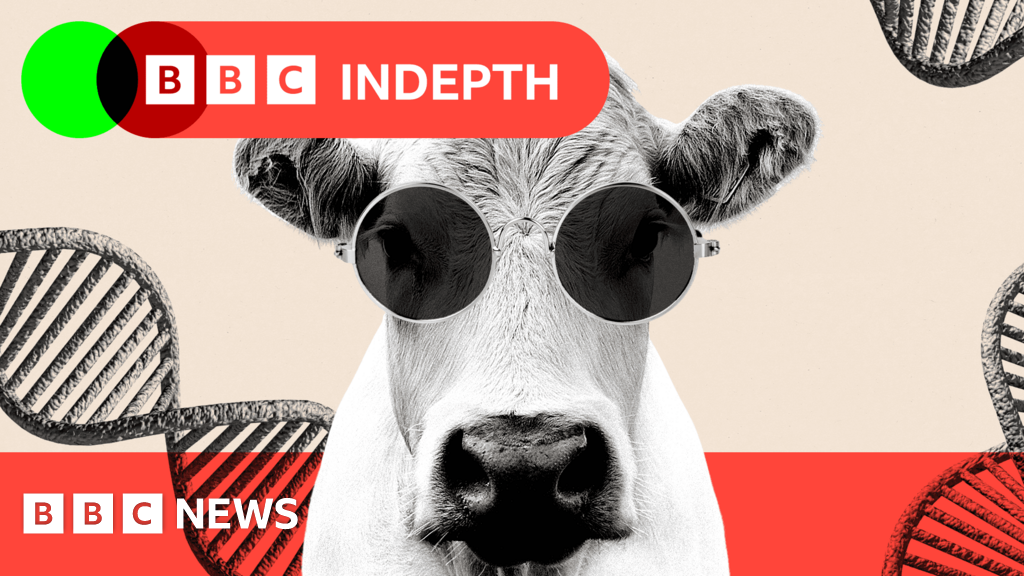
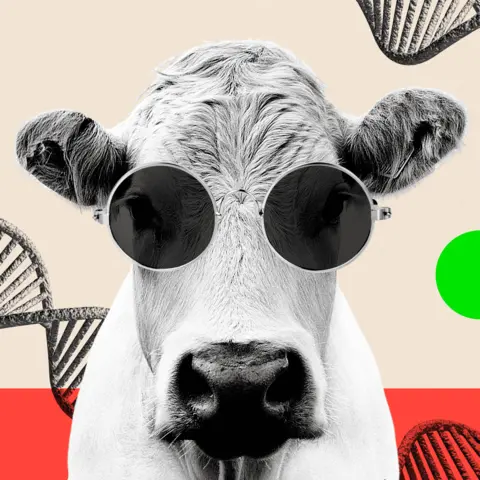 BBC
BBCThere’s nothing new about genetic engineering. By cross-breeding plants and animals, our Stone Age ancestors realised they could boost the amount of food they produced.
Modern genetics has enabled scientists to do much more: to make precise, targeted changes to the DNA of organisms in a lab. And that, they claim, will lead to new, more productive, disease-resistant crops and animals.
The science is still in its infancy, but gene-edited foods are already on the shelves in Japan: tomatoes rich in a chemical that supposedly promotes calmness; red sea bream with extra edible flesh; and puffer fish that grow more quickly.
In the US, too, firms are developing heat-resistant cattle, pit-less cherries and seedless blackberries.
Supporters of the technology say it could reduce animal diseases and suffering and lead to the use of fewer antibiotics. They also believe it could tackle climate change by lowering emissions of the greenhouse gas methane – produced by livestock such as cows, goats and deer when their stomachs are breaking down hard fibres like grass for digestion.
But opponents say gene editing is still not proven to be safe and that they remain concerned about the implications for animal welfare.
Now a law permitting gene-edited food to be sold in the UK has been paused and some British scientists warn they could be overtaken by other countries.
The new Labour government has pledged closer alignment with the European Union, particularly on regulations that might affect trade. And currently, the EU has much stricter rules around the commercial sale of gene-edited and genetically modified crops.
The EU set stringent regulations on genetically modified (GM) crops decades ago because of safety concerns and public opposition to the technology. Gene-edited crops are covered by the same regulations.
But to scientists, the terms “gene editing” and “GM” refer to different things.
GM, a much older technology, involves adding new genes to plants and animals to make them more productive or disease-resistant. Sometimes these new genes were from entirely different species – for example, a cotton plant with a scorpion gene to make it taste unpleasant to insects.
By contrast, gene editing involves making more precise changes to the plant or the animal’s DNA. These changes are often quite small ones, which involve editing sections of the DNA into a form that, its advocates say, could be produced through natural means like traditional cross-breeding, only much faster.
Dashed hopes
Along with the US and China, the UK is among the countries that lead the world in gene editing. Last year the previous government passed the Precision Breeding Act, which paved the way for the commercial sale of gene-edited food in England.
At the time, many scientists working in the field were overjoyed.
“I thought: ‘Great, this is going to uncork a whole area of activity in the public and private sector’ and we could build an entrepreneurial community for gene editing in the UK,” says Prof Jonathan Napier of Rothamsted Research, a government agricultural research institute in Harpenden.
But he says his hopes were soon dashed.
For the law to come into effect, secondary legislation was required, and this was due to be passed by Parliament this July. But the earlier-than-expected election meant that it was not voted on by MPs and the Act is currently in limbo.
Prof Napier was among 50 leading scientists to write to the newly appointed ministers at the Department for Food and Rural Affairs (Defra) at the end of July asking them to act “quickly and decisively” to pass the secondary legislation.
The Defra minister responsible, Daniel Zeichner, responded to the scientists’ plea last week by stating that the government was “now considering how to take forward the regulatory framework outlined in the Act and will share our plans with key interested parties soon”.
One of the prime movers behind the scientists’ letter, leading expert Prof Tina Barsby, described the minister’s response as a “encouraging” but said that his promise of clarity “soon” had to mean really soon.
Other countries, she said, were pressing ahead with their plans for gene edited-crops at great speed. Thailand recently joined Canada, Australia, Japan, Brazil, Argentina and the USA in adopting regulations around gene editing.
Even New Zealand, which according to Prof Barsby “has historically taken a more cautious regulatory approach to genetic technologies”, has announced that it will also introduce new legislation.
Prof Barsby added: “With our world-leading science base in genetic research, we cannot afford to be left behind.”
But Defra ministers also have to consider the views of environmental campaigners, such as Dr Helen Wallace of Genewatch UK, who have concerns about the “unwanted consequences” of the Precision Breeding Act.
“If you remove these plants and animals from GM regulations then you don’t have the same degree of risk assessment, you don’t have labelling and you risk markets because many of them regulate them as GMOs,” she says.
 Getty Images
Getty ImagesDr Peter Stevenson, who is the chief policy advisor to UK-based Compassion in World Farming (CIWF), also fears that the technology will further add to the intensification of animal farming – with negative consequences.
“The use of selective breeding over the past 50 years has brought a huge number of animal welfare problems,” he says.
“Chickens have been bred to grow so quickly that their legs and hearts can’t properly support the rapidly developing body and as a result millions of animals are suffering from painful leg disorders, while others succumb to heart disease.
“Do we really want to accelerate this process with gene editing?”
CIWF’s biggest fear is that gene-editing animals to make them more resistant to diseases will mean that the industry will not be motivated to deal with the conditions that lead to the animals getting ill in the first place – such as crowded, unsanitary conditions.
The intensity of the production of milk, meat, and eggs currently leaves many animals “exhausted and broken”, Mr Stevenson told BBC News.
Any genetic alteration to an animal has the potential to have negative effects. But advocates say that for any commercial application, firms have to demonstrate to the regulator that their changes do not harm the animal and back this up with data.
Indeed, many of those who argue for the use of gene-editing technology do so partly on animal welfare grounds – because it could make farm animals more resistant to disease and, since fewer would die as a result, fewer would be needed in the first place.
Another of the letter’s signatories is Prof Helen Sang, who has laid the foundations for using gene editing to develop bird flu resistance in chickens.
“With a virulent strain of (the pig disease) PRRS wiping out pig herds in Spain, African Swine Fever on the march north through Europe, and bird flu virus detected in both dairy cattle and their milk in the US, the importance of enabling all possible solutions, including precision breeding, cannot be overstated,” she said in response to Mr Zeichner.
Some of the solutions to the problems Prof Sang mentions are already waiting in the wings. She works at the Roslin Institute, where Dolly the Sheep was cloned nearly 30 years ago. It now leads the world in developing gene-edited animals.
 Getty Images
Getty ImagesProf Sang’s colleagues at Roslin developed a strain of pig that is resistant to the PRRS pig disease six years ago.
They can’t yet be commercially sold to UK pig farmers – but Genus, a British company that has commercialised the PRRS-resistant pigs, has received regulatory approval for their use in Colombia.
The firm also has an application for permission to introduce the pigs to the US market which, if given the green light, could be approved as early as next spring. Genus is also planning to seek approval for the commercial use of their gene-edited pigs in Canada, Mexico and Japan.
Despite the strong opinions on both sides, there appears to be scope for consensus around some applications of the technology.
For instance, Mr Stevenson of CIWF does think it’s at least possible that gene editing could be applied in an ethical way.
To do so, he says, it would need to meet three criteria: that any change it brings about is unlikely to cause animal welfare problems; that its objectives cannot be met by any less intensive means; and that it will not have the effect of entrenching industrialised livestock production.
The PRRS-resistant pigs may tick all three boxes in specific circumstances, according to Mr Stevenson, as do efforts to use gene editing to enable the egg-production industry to produce female-only chicks to avoid the need for billions of male chicks being killed each year when they are just a day old.
Likewise, Prof Mizeck Chagunda, who is the director of the Centre for Tropical Genetics and Health, which is also based at the Roslin Institute, believes both in the positive potential of gene editing and that it needs to be carefully overseen.
He says the technology could improve the lives of the poorest farmers in the world: “70% to 80% of farmers are smallholding farms with two to three animals.” A devastating disease can leave a farmer and their family with nothing.
“So, giving them animals that have been prepared with these technologies would help to protect them from this huge risk to their livelihoods,” says Prof Chagunda.
However, Prof Chagunda warns that there needs to be good, strong regulations in place if this technology is to be accepted by the public.
“Some changes can be too experimental, and we should not be doing them,” he says.
“Scientists should be working with the regulatory authorities to achieve the good products that the farmers and consumers are looking for. We should be doing science that is ethical and at the same time helping humanity.”
The gene editing work at Roslin is led by its director, Prof Bruce Whitelaw, who was a scientist at the institute when Dolly the sheep was cloned. In the past he has been through the process of explaining the potential benefits of seemingly alarming technological developments and he believes there is an urgent need to do so again now.
“We are world leaders in the technology and sitting at top table in terms of developing it,” he says. “If we don’t have the legislation to do that, then our credentials to sit there will slowly wither away and we will lose investment, scientific talent and the boost to our economy to other countries.”
There are lessons here from the past. Genetic modification was rejected by many consumers in the UK, the European Union and other countries 30 years ago because of its perceived unnaturalness. GM crops were publicly trampled by protestors who saw this as a technology that they didn’t need, want or consider safe.
At the same time, scientists were angry and upset that what they believed to be their world-saving technology was being destroyed by, in their view, a wave of anti-scientific hysteria fuelled by the media.
Gene editing seems to be a more palatable version of GM to some, arriving at a time when the debate is less polarised, the need for environmental solutions is even more urgent and there seems to be a greater readiness for some scientists and campaigners to see each other’s perspectives.
Mr Stevenson of CWIF believes that in the long run, there has to be “huge reductions” in global livestock production to deal with climate change, but pragmatically, the fact that climate change is already destroying so many lives, the use of gene editing could be “legitimate”. But he is wary.
“It is hard for me to trust that part of the scientific world who say: ‘Hey now, we have a new way to alter animals.’
“The danger is of animals being thought of as things, units of production, more so than they are now, because we can modify them to make them more amenable to our uses and taking us away from this notion of animals as sentient beings.”
What happens next, not just in the UK, but the rest of the world, depends on whether the advocates of gene editing can convince the open-minded, but wary, such as Mr Stevenson, that they can act safely, ethically and in a way that makes lives better, not worse – for people and animals alike.
BBC InDepth is the new home on the website and app for the best analysis and expertise from our top journalists. Under a distinctive new brand, we’ll bring you fresh perspectives that challenge assumptions, and deep reporting on the biggest issues to help you make sense of a complex world. And we’ll be showcasing thought-provoking content from across BBC Sounds and iPlayer too. We’re starting small but thinking big, and we want to know what you think – you can send us your feedback by clicking on the button below.
Science & Environment
Drones setting a new standard in ocean rescue technology
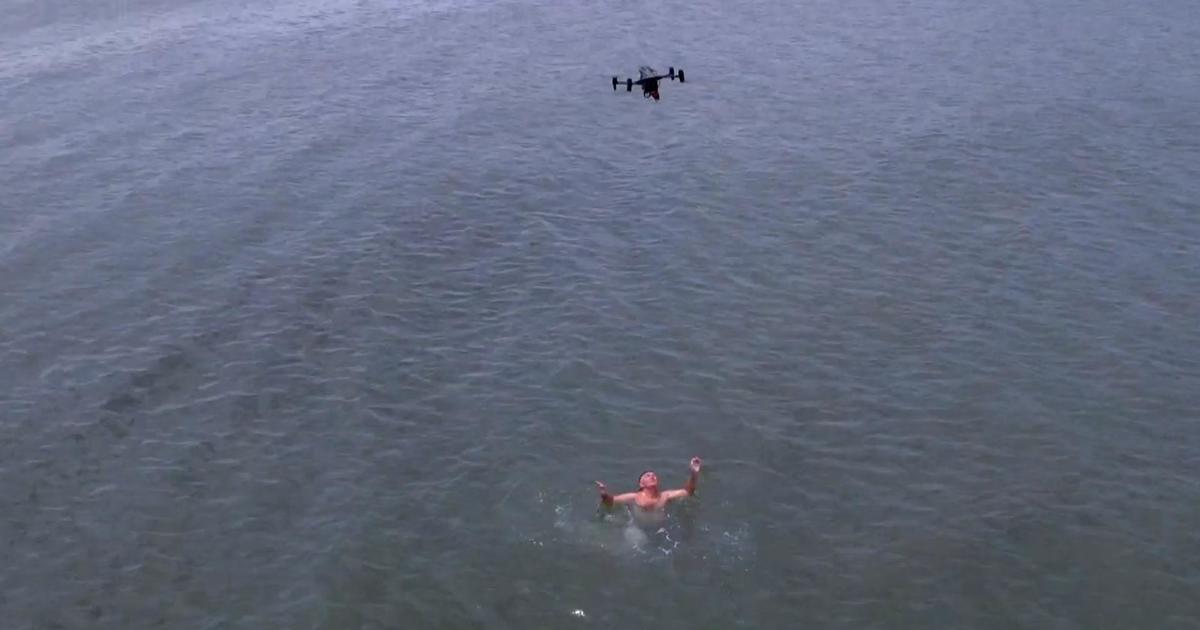
Last month, two young paddleboarders found themselves stranded in the ocean, pushed 2,000 feet from the shore by strong winds and currents. Thanks to the deployment of a drone, rescuers kept an eye on them the whole time and safely brought them aboard a rescue boat within minutes.
In North Carolina, the Oak Island Fire Department is one of a few in the country using drone technology for ocean rescues. Firefighter-turned-drone pilot Sean Barry explained the drone’s capabilities as it was demonstrated on a windy day.
“This drone is capable of flying in all types of weather and environments,” Barry said.
Equipped with a camera that can switch between modes — including infrared to spot people in distress — responders can communicate instructions through a speaker. It also can carry life-preserving equipment.
The device is activated by a CO2 cartridge when it comes in contact with water. Once triggered, it inflates into a long tube, approximately 26 inches long, providing distressed swimmers something to hold on to.
In a real-life rescue, after a 911 call from shore, the drone spotted a swimmer in distress. It released two floating tubes, providing the swimmer with buoyancy until help arrived.
Like many coastal communities, Oak Island’s population can swell from about 10,000 to 50,000 during the summer tourist season. Riptides, which are hard to detect on the surface, can happen at any time.
Every year, about 100 people die due to rip currents on U.S. beaches. More than 80% of beach rescues involve rip currents, if you’re caught in one, rescuers advise to not panic or try to fight it, but try to float or swim parallel to the coastline to get out of the current.
Oak Island Fire Chief Lee Price noted that many people underestimate the force of rip currents.
“People are, ‘Oh, I’m a good swimmer. I’m gonna go out there,’ and then they get in trouble,” Price said.
For Price, the benefit of drones isn’t just faster response times but also keeping rescuers safe. Through the camera and speaker, they can determine if someone isn’t in distress.
Price said many people might not be aware of it.
“It’s like anything as technology advances, it takes a little bit for everybody to catch up and get used to it,” said Price.
In a demonstration, Barry showed how the drone can bring a safety rope to a swimmer while rescuers prepare to pull the swimmer to shore.
“The speed and accuracy that this gives you … rapid deployment, speed, accuracy, and safety overall,” Price said. “Not just safety for the victim, but safety for our responders.”
Science & Environment
Horseshoe crabs: Ancient creatures who are a medical marvel
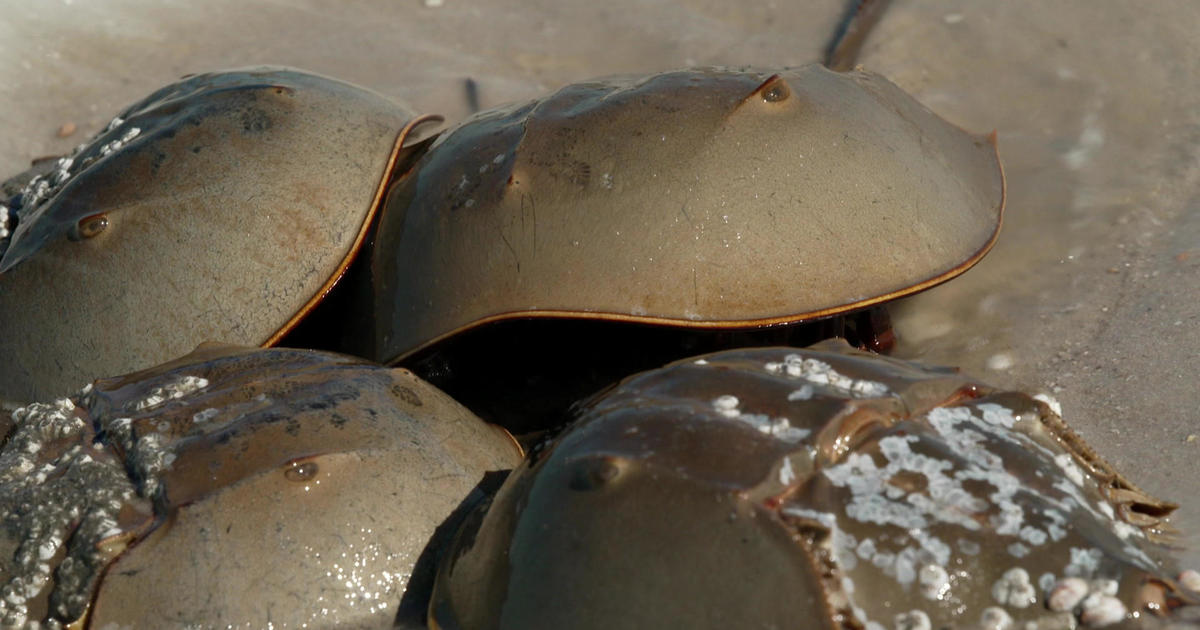
Watch CBS News
Be the first to know
Get browser notifications for breaking news, live events, and exclusive reporting.
Science & Environment
SpaceX to launch bitcoin entrepreneur and three crewmates on flight around Earth’s poles

A blockchain entrepreneur, a cinematographer, a polar adventurer and a robotics researcher plan to fly around Earth’s poles aboard a SpaceX Crew Dragon capsule by the end of the year, becoming the first humans to observe the ice caps and extreme polar environments from orbit, SpaceX announced Monday.
The historic flight, launched from the Kennedy Space Center in Florida, will be commanded by Chun Wang, a wealthy bitcoin pioneer who founded f2pool and stakefish, “which are among the largest Bitcoin mining pools and Ethereum staking providers,” the crew’s website says.
“Wang aims to use the mission to highlight the crew’s explorational spirit, bring a sense of wonder and curiosity to the larger public and highlight how technology can help push the boundaries of exploration of Earth and through the mission’s research,” SpaceX said on its website.
Wang’s crewmates are Norwegian cinematographer Jannicke Mikkelsen, Australian adventurer Eric Philips and Rabea Rogge, a German robotics researcher. All four have an interest in extreme polar environments and plan to carry out related research and photography from orbit.
The mission, known as “Fram2” in honor of a Norwegian ship used to explore both the Arctic and Antarctic regions, will last three to five days and fly at altitudes between about 265 and 280 miles.
“This looks like a cool & well thought out mission. I wish the @framonauts the best on this epic exploration adventure!” tweeted Jared Isaacman, the billionaire philanthropist who charted the first private SpaceX mission — Inspiration4 — and who plans to blast off on a second flight — Polaris Dawn — later this month.
The flights “showcase what commercial missions can achieve thanks to @SpaceX’s reusability and NASA’s vision with the commercial crew program,” Isaacman said. “All just small steps towards unlocking the last great frontier.”
Like the Inspiration4 mission before them, Wang and his crewmates will fly in a Crew Dragon equipped with a transparent cupola giving them a picture-window view of Earth below and deep space beyond.
No astronauts or cosmonauts have ever viewed Earth from the vantage point of a polar orbit, one tilted, or inclined, 90 degrees to the equator. Such orbits are favored by spy satellites, weather stations and commercial photo-reconnaissance satellites because they fly over the entire planet as it rotates beneath them.
The high-inclination record for piloted flight was set in the early 1960s by Soviet Vostok spacecraft launched into orbits inclined 65 degrees. The U.S. record was set by a space shuttle mission launched in 1990 that carried out a classified military mission in an orbit tilted 62 degrees with respect to the equator.
The International Space Station never flies beyond 51.6 degrees north and south latitude. NASA planned to launch a space shuttle on a classified military mission around the poles in 1986, but the flight was canceled in the wake of the Challenger disaster.
“The North and South Poles are invisible to astronauts on the International Space Station, as well as to all previous human spaceflight missions except for the Apollo lunar missions but only from far away,” the Fram2 website says. “This new flight trajectory will unlock new possibilities for human spaceflight.”
SpaceX has launched 13 piloted missions carrying 50 astronauts, cosmonauts and private citizens to orbit in nine NASA flights to the space station, three commercial visits to the lab and the Inspiration4 mission chartered by Isaacman.
Isaacman and three crewmates plan to blast off Aug. 26 on another fully commercial flight, this one featuring the first civilian spacewalks. NASA plans to launch its next Crew Dragon flight to the space station around Sept. 24.
Science & Environment
Giant “flying” Joro spiders love big cities. A new study found their ability to chill out in stressful situations may be why
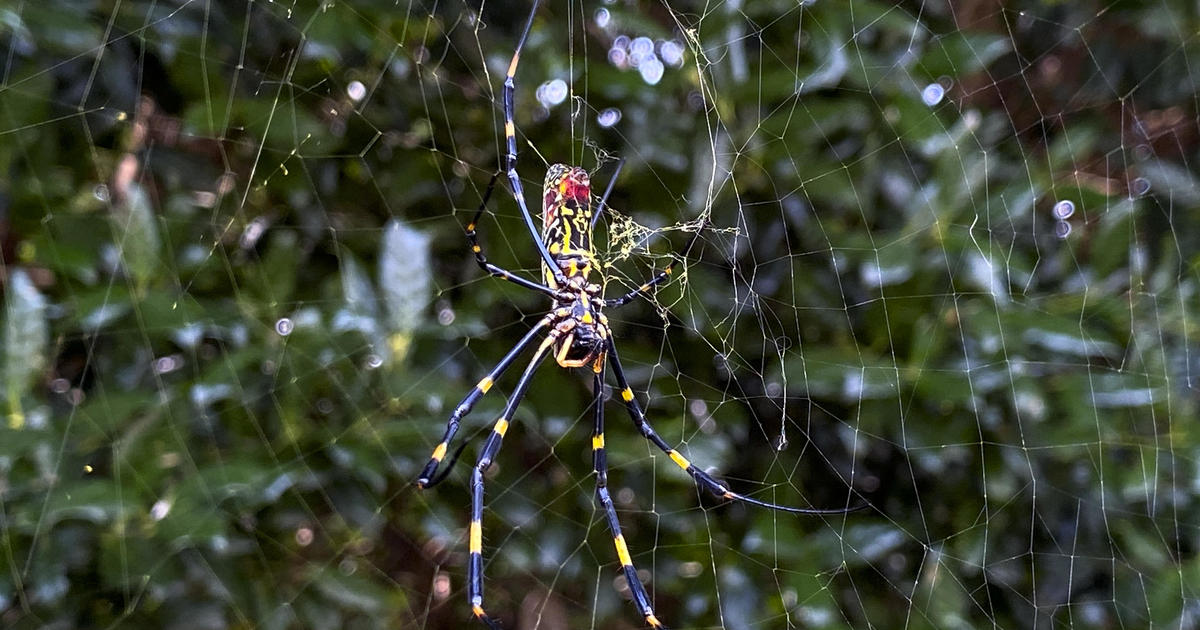
The saga of the large invasive Joro spiders that parachute through the air isn’t over. A new study found that the critters with 4-inch-long legs are truly built differently, with hearts that are able to withstand the loud and bustling noises of big cities.
University of Georgia researcher Andy Davis made the discovery while conducting cardiac stress tests on Joro spiders and their cousin, the golden silk spider. The research, published in Physiological Entomology on Monday, found that the species know how to chill out and stay calm when put in heart rate-raising situations.
The Joro spider, also known as Trichonephila clavata, “is known for making webs not only in natural green spaces but also in cities and towns, often on buildings and human dwellings,” the study says. “The stress reactions of Trichonephila spiders could be characterized as ‘even-tempered,’ which may factor into their ability to live in habitats with frequent disturbances.”
Davis and his team evaluated the physiological reactions of Joro spiders and golden silk spiders and compared them to those of another pair of similarly-sized species that are related to each other, garden spiders and banded garden spiders.
Researchers recorded baseline heart rates of the arachnids while they were resting and inactive, and then recorded their heart rates after restraining them under electronic sensors for 10 minutes.
“When subjected to the novel restraint stress, heart rates of all spider species became elevated, which is an expected reaction that other spider researchers have noted,” the study says. “However, there were differences among species in the magnitude of this elevation, and of how the responses progressed during the 10 min period.”
The garden spiders, both of which belong to the Argiope genus, showed “distinct periods of fluctuations during the restraint” and were even found to struggle against the restraints, researchers said. Joro spiders and their golden silk cousins, on the other hand, were “less variable and more even.” They were also observed entering a state of thanatosis for more than an hour after stressors, meaning they essentially froze up during that time.
The tests “are beginning to paint a picture of how the invasive Joro spider and its cousin, the golden silk spider, have a unique way of tolerating novel stressors, which may be the reason for their ability to occupy anthropogenic landscapes,” researchers said, noting that other spider species in their family line could share this trait, although that would need further investigation.
Joro spiders have been making headlines for years as they continue to spread up the East Coast. Originally from Asia, the spiders are believed to have been first introduced to north Georgia around 2010. They have since been found across nearly a dozen other states. In December, Davis told The New York Times that New York is “right in the middle of where they like to be.” It’s been predicted that they could pop up in the New York tri-state area this summer, although no reports of such have been made.
“They seem to be OK with living in a city,” he told the paper, adding that they’ve been seen hanging out on street lamps and telephone poles, where “regular spiders wouldn’t be caught dead in.”
The latest findings may not definitively prove that the spiders’ relaxed demeanor is the reason for “their affinity for urban settings,” the study says, adding that more research is needed. It does, however, bolster Davis’ research from February, which also found that Joro spiders don’t necessarily mind the increased noise and vibrations that come with city living.
“These Joro webs are everywhere in the fall, including right next to busy roads, and the spiders seem to be able to make a living there. For some reason, these spiders seem urban tolerant,” Davis said of his earlier research.
UGA student and co-author of that study, Alexa Schultz, agreed, saying, “It looks like Joro spiders are not going to shy away from building a web under a stoplight or an area where you wouldn’t imagine a spider to be.”
But don’t worry — while the spiders are venomous, they don’t pose a danger to humans, although they may elevate your heart rate more than you elevate theirs.
Science & Environment
New volcanic eruption in Iceland brings video of lava spewing from miles-long fissure on Reykjanes peninsula

Reykjavik — Icelandic authorities said Friday that a second fissure had formed on the southwestern Reykjanes peninsula after lava started spewing forth for the sixth time in the region since December. After weeks of warnings, the Icelandic Meteorological Office (IMO) said Thursday that a new eruption had started at 9:26 p.m. (5:26 p.m. Eastern) that evening, following a series of earthquakes.
Video showed orange lava bursting out of a long fissure, which the IMO estimated to be 2.4 miles.
Early Friday, the IMO announced on social media that a second fissure had opened up to the north of the original one, but it said the volcanic activity mostly remained on the first crack.
The weather agency, which also monitors geological events, had previously reported that there was “considerable seismic activity” at the northern end of the fissure.
About an hour after the eruption started an earthquake with a magnitude of 4.1 was recorded in the area.
This is the sixth eruption to hit the area since December, coming just two months after the end of a previous eruption that lasted more than three weeks.
The chief of police of the Sudurnes region, Ulfar Ludviksson, told Icelandic media that the evacuation of the nearby fishing village of Grindavik had gone well.
He added that 22 or 23 houses in the village were currently occupied. Most of Grindavik’s 4,000 residents had evacuated in November, prior to a December eruption, and while residents have since been allowed to return in between eruptions, only a few have opted to stay overnight.
According to the IMO, there was no lava flowing towards Grindavik in the latest eruption.
Iceland’s famed Blue Lagoon thermal spa tourist attraction said late Thursday that it had taken “the precautionary measure of evacuating and temporarily closing all our operational units.”
The Reykjanes peninsula had not experienced an eruption for eight centuries until March 2021. Further eruptions occurred in August 2022 and in July and December 2023, leading volcanologists to warn that a new era of seismic activity had begun in the region.
Iceland is home to 33 active volcano systems, the highest number in Europe. It straddles the Mid-Atlantic Ridge, a crack in the ocean floor separating the Eurasian and North American tectonic plates.
Science & Environment
Matching dinosaur footprints found more than 3,700 miles apart, on different continents
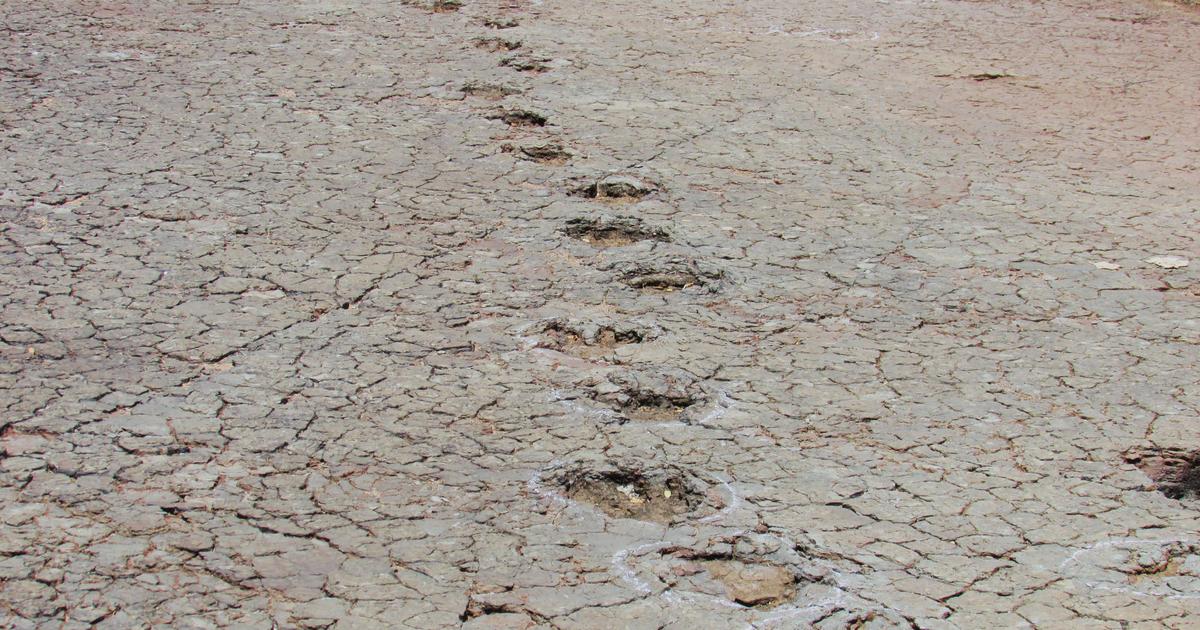
A team of paleontologists found matching dinosaur footprints on what are now two different continents, separated by thousands of miles of ocean.
The footprints, dating back to the Early Cretaceous period, were found in Brazil and in Cameroon, researchers wrote in a study published Monday by the New Mexico Museum of Natural History & Science. The discovery shows where land-dwelling dinosaurs were able to cross freely between South America and Africa before the two continents split apart millions of years ago.
Land shifts
The more than 260 footprints researchers studied were found impressed into mud and silt along ancient rivers and lakes, with more than 3,700 miles separating the ones in South America and Africa, according to the study. Paleontologists determined they were similar in age, shape and in geological and plate tectonic contexts.
Dinosaurs made the tracks 120 million years ago on a single supercontinent known as Gondwana, which had broken off from the larger landmass of Pangea — once the world’s only continent, Southern Methodist University paleontologist Louis Jacobs said.
“One of the youngest and narrowest geological connections between Africa and South America was the elbow of northeastern Brazil nestled against what is now the coast of Cameroon along the Gulf of Guinea,” Jacobs, the lead study author, said. “The two continents were continuous along that narrow stretch, so that animals on either side of that connection could potentially move across it.”
The continents now known as Africa and South America started to split around 140 million years ago, researchers said. The south Atlantic Ocean eventually filled the void.
Basins formed as the continents pulled apart; rivers flowed and lakes formed in those basins, Jacobs said. The basins where the footprints were discovered can be found on both sides of the split.
What we know about the dinosaurs
Most of the footprints were made by three-toed theropods, a group of carnivorous dinosaurs, researchers said. There were also prints left behind by sauropods or ornithischians.
“Plants fed the herbivores and supported a food chain,” Jacobs said. “Muddy sediments left by the rivers and lakes contain dinosaur footprints, including those of meat-eaters, documenting that these river valleys could provide specific avenues for life to travel across the continents 120 million years ago.”
-

 Sport8 hours ago
Sport8 hours agoJoshua vs Dubois: Chris Eubank Jr says ‘AJ’ could beat Tyson Fury and any other heavyweight in the world
-

 News1 day ago
News1 day agoYou’re a Hypocrite, And So Am I
-

 News8 hours ago
News8 hours agoIsrael strikes Lebanese targets as Hizbollah chief warns of ‘red lines’ crossed
-

 CryptoCurrency7 hours ago
CryptoCurrency7 hours agoEthereum is a 'contrarian bet' into 2025, says Bitwise exec
-

 Technology6 hours ago
Technology6 hours agoiPhone 15 Pro Max Camera Review: Depth and Reach
-

 CryptoCurrency7 hours ago
CryptoCurrency7 hours ago2 auditors miss $27M Penpie flaw, Pythia’s ‘claim rewards’ bug: Crypto-Sec
-

 CryptoCurrency7 hours ago
CryptoCurrency7 hours agoTreason in Taiwan paid in Tether, East’s crypto exchange resurgence: Asia Express
-

 CryptoCurrency7 hours ago
CryptoCurrency7 hours agoJourneys: Robby Yung on Animoca’s Web3 investments, TON and the Mocaverse
-

 CryptoCurrency7 hours ago
CryptoCurrency7 hours agoAre there ‘too many’ blockchains for gaming? Sui’s randomness feature: Web3 Gamer
-

 CryptoCurrency7 hours ago
CryptoCurrency7 hours agoHelp! My parents are addicted to Pi Network crypto tapper
-

 CryptoCurrency7 hours ago
CryptoCurrency7 hours ago‘Everything feels like it’s going to shit’: Peter McCormack reveals new podcast
-

 CryptoCurrency7 hours ago
CryptoCurrency7 hours agoSEC sues ‘fake’ crypto exchanges in first action on pig butchering scams
-

 CryptoCurrency7 hours ago
CryptoCurrency7 hours agoDecentraland X account hacked, phishing scam targets MANA airdrop
-

 CryptoCurrency7 hours ago
CryptoCurrency7 hours agoBitcoin miners steamrolled after electricity thefts, exchange ‘closure’ scam: Asia Express
-

 CryptoCurrency7 hours ago
CryptoCurrency7 hours agoCertiK Ventures discloses $45M investment plan to boost Web3
-

 CryptoCurrency7 hours ago
CryptoCurrency7 hours agoMemecoins not the ‘right move’ for celebs, but DApps might be — Skale Labs CMO
-

 CryptoCurrency7 hours ago
CryptoCurrency7 hours agoDorsey’s ‘marketplace of algorithms’ could fix social media… so why hasn’t it?
-

 CryptoCurrency7 hours ago
CryptoCurrency7 hours agoLow users, sex predators kill Korean metaverses, 3AC sues Terra: Asia Express
-

 CryptoCurrency7 hours ago
CryptoCurrency7 hours agoSEC asks court for four months to produce documents for Coinbase
-

 Science & Environment10 hours ago
Science & Environment10 hours ago‘Running of the bulls’ festival crowds move like charged particles
-

 Sport7 hours ago
Sport7 hours agoUFC Edmonton fight card revealed, including Brandon Moreno vs. Amir Albazi headliner
-

 MMA7 hours ago
MMA7 hours agoUFC’s Cory Sandhagen says Deiveson Figueiredo turned down fight offer
-

 Football7 hours ago
Football7 hours agoNiamh Charles: Chelsea defender has successful shoulder surgery
-

 Science & Environment10 hours ago
Science & Environment10 hours agoRethinking space and time could let us do away with dark matter
-

 Science & Environment10 hours ago
Science & Environment10 hours agoHow one theory ties together everything we know about the universe
-

 CryptoCurrency7 hours ago
CryptoCurrency7 hours agoSEC settles with Rari Capital over DeFi pools, unregistered broker activity
-

 News5 hours ago
News5 hours agoBrian Tyree Henry on voicing young Megatron, his love for villain roles
-

 Science & Environment21 hours ago
Science & Environment21 hours agoQuantum time travel: The experiment to ‘send a particle into the past’
-

 Science & Environment7 hours ago
Science & Environment7 hours agoWe may have spotted a parallel universe going backwards in time
-

 CryptoCurrency7 hours ago
CryptoCurrency7 hours agoArthur Hayes’ ‘sub $50K’ Bitcoin call, Mt. Gox CEO’s new exchange, and more: Hodler’s Digest, Sept. 1 – 7
-

 CryptoCurrency7 hours ago
CryptoCurrency7 hours agoLeaked Chainalysis video suggests Monero transactions may be traceable
-

 CryptoCurrency7 hours ago
CryptoCurrency7 hours agoLouisiana takes first crypto payment over Bitcoin Lightning
-

 CryptoCurrency7 hours ago
CryptoCurrency7 hours agoCrypto whales like Humpy are gaming DAO votes — but there are solutions
-

 CryptoCurrency7 hours ago
CryptoCurrency7 hours agoFive crypto market predictions that haven’t come true — yet
-

 CryptoCurrency7 hours ago
CryptoCurrency7 hours ago$12.1M fraud suspect with ‘new face’ arrested, crypto scam boiler rooms busted: Asia Express
-

 CryptoCurrency7 hours ago
CryptoCurrency7 hours agoReal-world asset tokenization is the crypto killer app — Polygon exec
-

 Science & Environment10 hours ago
Science & Environment10 hours agoFuture of fusion: How the UK’s JET reactor paved the way for ITER
-

 CryptoCurrency7 hours ago
CryptoCurrency7 hours agoFed rate cut may be politically motivated, will increase inflation: Arthur Hayes
-

 CryptoCurrency7 hours ago
CryptoCurrency7 hours agoBinance CEO says task force is working ‘across the clock’ to free exec in Nigeria
-

 CryptoCurrency7 hours ago
CryptoCurrency7 hours agoElon Musk is worth 100K followers: Yat Siu, X Hall of Flame
-

 CryptoCurrency7 hours ago
CryptoCurrency7 hours agoBitcoin price hits $62.6K as Fed 'crisis' move sparks US stocks warning
-

 CryptoCurrency7 hours ago
CryptoCurrency7 hours agoCZ and Binance face new lawsuit, RFK Jr suspends campaign, and more: Hodler’s Digest Aug. 18 – 24
-

 CryptoCurrency7 hours ago
CryptoCurrency7 hours agoCardano founder to meet Argentina president Javier Milei
-

 CryptoCurrency7 hours ago
CryptoCurrency7 hours agoBitcoin bull rally far from over, MetaMask partners with Mastercard, and more: Hodler’s Digest Aug 11 – 17
-

 CryptoCurrency7 hours ago
CryptoCurrency7 hours agoTelegram bot Banana Gun’s users drained of over $1.9M
-

 CryptoCurrency7 hours ago
CryptoCurrency7 hours agoEthereum falls to new 42-month low vs. Bitcoin — Bottom or more pain ahead?
-

 CryptoCurrency7 hours ago
CryptoCurrency7 hours agoBlockdaemon mulls 2026 IPO: Report
-
Business6 hours ago
How Labour donor’s largesse tarnished government’s squeaky clean image
-
Business6 hours ago
UK hospitals with potentially dangerous concrete to be redeveloped
-
Business5 hours ago
Axel Springer top team close to making eight times their money in KKR deal
-

 News5 hours ago
News5 hours ago“Beast Games” contestants sue MrBeast’s production company over “chronic mistreatment”
-

 News5 hours ago
News5 hours agoSean “Diddy” Combs denied bail again in federal sex trafficking case
-

 News5 hours ago
News5 hours agoSean “Diddy” Combs denied bail again in federal sex trafficking case in New York
-

 News5 hours ago
News5 hours agoBrian Tyree Henry on his love for playing villains ahead of “Transformers One” release
-

 News5 hours ago
News5 hours agoBrian Tyree Henry on voicing young Megatron, his love for villain roles
-

 Technology3 days ago
Technology3 days agoYouTube restricts teenager access to fitness videos
-

 News9 hours ago
News9 hours agoChurch same-sex split affecting bishop appointments
-

 Politics2 days ago
Politics2 days agoTrump says he will meet with Indian Prime Minister Narendra Modi next week
-

 Science & Environment11 hours ago
Science & Environment11 hours agoPhysicists have worked out how to melt any material
-

 Politics21 hours ago
Politics21 hours agoWhat is the House of Lords, how does it work and how is it changing?
-

 Politics22 hours ago
Politics22 hours agoKeir Starmer facing flashpoints with the trade unions
-

 Technology8 hours ago
Technology8 hours agoFivetran targets data security by adding Hybrid Deployment
-
News8 hours ago
Freed Between the Lines: Banned Books Week
-

 MMA7 hours ago
MMA7 hours agoDiego Lopes declines Movsar Evloev’s request to step in at UFC 307
-

 Football7 hours ago
Football7 hours agoSlot's midfield tweak key to Liverpool victory in Milan
-

 Science & Environment10 hours ago
Science & Environment10 hours agoHow to wrap your head around the most mind-bending theories of reality
-

 Fashion Models6 hours ago
Fashion Models6 hours agoMiranda Kerr nude
-

 Fashion Models6 hours ago
Fashion Models6 hours ago“Playmate of the Year” magazine covers of Playboy from 1971–1980
-

 Health & fitness2 days ago
Health & fitness2 days ago11 reasons why you should stop your fizzy drink habit in 2022
-

 Politics6 hours ago
Politics6 hours agoLabour MP urges UK government to nationalise Grangemouth refinery
-

 Science & Environment14 hours ago
Science & Environment14 hours agoHow Peter Higgs revealed the forces that hold the universe together
-

 News4 days ago
News4 days agoIndia Now Moves from Deliberations to Deliverables on Crimes Against Women
-

 Science & Environment9 hours ago
Science & Environment9 hours agoOdd quantum property may let us chill things closer to absolute zero
-

 Science & Environment16 hours ago
Science & Environment16 hours agoQuantum forces used to automatically assemble tiny device
-

 Entertainment5 hours ago
Entertainment5 hours ago“Jimmy Carter 100” concert celebrates former president’s 100th birthday
-

 Science & Environment18 hours ago
Science & Environment18 hours agoSunlight-trapping device can generate temperatures over 1000°C
-

 News5 hours ago
News5 hours agoJoe Posnanski revisits iconic football moments in new book, “Why We Love Football”
-

 Health & fitness2 days ago
Health & fitness2 days agoHow to adopt mindful drinking in 2022
-

 Health & fitness2 days ago
Health & fitness2 days agoWhat 10 days of a clean eating plan actually does to your body and why to adopt this diet in 2022
-

 Health & fitness2 days ago
Health & fitness2 days agoWhen Britons need GoFundMe to pay for surgery, it’s clear the NHS backlog is a political time bomb
-

 Science & Environment21 hours ago
Science & Environment21 hours agoQuantum to cosmos: Why scale is vital to our understanding of reality
-

 Technology3 days ago
Technology3 days agoTrump says Musk could head ‘government efficiency’ force
-

 Science & Environment1 day ago
Science & Environment1 day agoParticle physicists may have solved a strange mystery about the muon
-

 Science & Environment22 hours ago
Science & Environment22 hours agoHow the weird and powerful pull of black holes made me a physicist
-

 Politics20 hours ago
Politics20 hours agoIs there a £22bn ‘black hole’ in the UK’s public finances?
-

 Science & Environment20 hours ago
Science & Environment20 hours agoX-ray laser fires most powerful pulse ever recorded
-

 Science & Environment19 hours ago
Science & Environment19 hours agoHow indefinite causality could lead us to a theory of quantum gravity
-

 Science & Environment18 hours ago
Science & Environment18 hours agoDoughnut-shaped swirls of laser light can be used to transmit images
-

 Science & Environment17 hours ago
Science & Environment17 hours agoWhy we are finally within reach of a room-temperature superconductor
-

 Science & Environment17 hours ago
Science & Environment17 hours agoBlack holes scramble information – but may not be the best at it
-

 Science & Environment16 hours ago
Science & Environment16 hours agoThe galactic anomalies hinting dark matter is weirder than we thought
-

 CryptoCurrency7 hours ago
CryptoCurrency7 hours agoBitcoin will ‘start ripping’ as Trump’s polls improve: Felix Hartmann, X Hall of Flame
-

 CryptoCurrency7 hours ago
CryptoCurrency7 hours agoTelegram CEO cannot leave France, OpenSea receives Wells notice, and more: Hodler’s Digest, Aug. 25 – 31
-

 CryptoCurrency7 hours ago
CryptoCurrency7 hours agoSolana unveils new Seeker device, says it’s not just a ‘memecoin phone’
-

 CryptoCurrency7 hours ago
CryptoCurrency7 hours agoCrypto scammers orchestrate massive hack on X but barely made $8K
-

 CryptoCurrency7 hours ago
CryptoCurrency7 hours agoBitcoiners are ‘all in’ on Trump since Bitcoin ’24, but it’s getting risky
-

 Science & Environment10 hours ago
Science & Environment10 hours ago‘Sound laser’ is the most powerful ever made
-

 Science & Environment10 hours ago
Science & Environment10 hours agoJupiter’s stormy surface replicated in lab
-

 Science & Environment10 hours ago
Science & Environment10 hours agoA tale of two mysteries: ghostly neutrinos and the proton decay puzzle
-
Politics10 hours ago
Owen Paterson loses ECHR appeal against report that preceded downfall | Owen Paterson







You must be logged in to post a comment Login